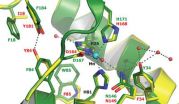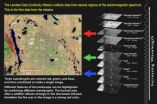(Press-News.org) GAINESVILLE, Fla. — A new University of Florida study of nearly 5,000 Haiti bird fossils shows contrary to a commonly held theory, human arrival 6,000 years ago didn't cause the island's birds to die simultaneously.
Although many birds perished or became displaced during a mass extinction event following the first arrival of humans to the Caribbean islands, fossil evidence shows some species were more resilient than others. The research provides range and dispersal patterns from A.D. 600 to 1600 that may be used to create conservation plans for tropical mountainous regions, some of the most threatened habitats worldwide. Understanding what caused recent extinctions – whether direct habitat loss or introduction of invasive species — helps researchers predict future ecological impacts. The study was published online in The Holocene March 12 and is scheduled to appear in the journal's print edition in July.
"People arrive about 6,000 years ago and within a millennium or two, you lose the big, spectacular critters — the ground sloths, the monkeys, the biggest rodents and some of the big extinct birds, like giant owls and eagles," said lead author David Steadman, ornithology curator at the Florida Museum of Natural History on the UF campus. "We have some bird species from our fossil site that, from a modern standpoint, are just as extinct as the others, but in fact, they almost were able to survive longer. That helps give us a gauge on what the future might bring."
Researchers used comparisons with modern bones to identify 23 species from the 4,857 bird fossils excavated from Trouing Jean Paul, a cave in southeast Haiti at an elevation of about 6,000 feet. The most common bird species include the Zenaida Dove, the Black Swift, the Least Pauraque, the Hispaniolan woodpecker and a new, undescribed extinct woodcock in the genus Scolopax. Researchers believe the woodcock became extinct between A.D. 1350 and 1800, surviving the first arrival of the Amerindians 6,000 years ago, but dying off following the arrival of Europeans and African peoples in 1492, Steadman said.
"When you take a look at what could've caused this, it really does just keep pointing to humans," Steadman said. "I just think it's habitat loss from people and introduction of non-native, invasive plants and animals. It's the same thing we're dealing with in Florida now — who knows what the pythons are going to wipe out in the Everglades."
Researchers radiocarbon-dated six individual bones from the extinct woodcock to determine the site's age. Because the locality also includes fossils of frogs, lizards, snakes, bats and rodents, in addition to the Common Barn Owl and Ashy-faced Owl, it was likely a roost where owls deposited boney pellets of their prey, scientists said.
Of the present-day species found at the site, as many as one-third are considered threatened today and four of the 23 total species are no longer found in the area. Their predominant habitat was pine forests, which are mostly disturbed today or entirely cut down for agriculture. The Least Pauraque, a type of nightjar, is now an endangered species that lives in an extremely localized area, Steadman said.
"This gives us some evidence of how drastic the range contraction was of this species — the Least Pauraque not only lived in the mountains, it was common there," Steadman said. "Within 1,000 years, it's lost most of its range and most of its population. From the standpoint of evolution, if we want that species to ever have the opportunity to evolve through time, we need to be concerned with time intervals that are measured in centuries and millennia, not just decades."
Jim Mead, professor and chair of the department of geosciences at East Tennessee State University, said the research is important because the direct radiocarbon dating represents a much later time period than the arrival of the first Amerindians.
"What Steadman is finding, more often than not, is that we as people bring in other things with us and indirectly wipe out other animals," said Mead, who was not involved with the study. "He's providing background data and I think that's critical to Hispaniola because you have two countries on that island and they're quite different culturally and economically, so those countries are going to play different games on the local fauna."
Mead said it is also significant that Trouing Jean Paul occurs at a high elevation, where human or climate pressures could result in animals finding a "refugia" upslope.
"Typically, a lot of sites are found in lower elevation, or we go to the lower elevations to look at localities we work on," Mead said. "But Dave is saying, 'Why don't we look at these other areas that haven't really been examined?' This one cave is a critical one for that. It gives us a 3-D look at environments on an island."
Oona Takano, who helped sort and identify the specimens as a UF undergraduate student, is a study co-author.
###
Credits
Writer
Danielle Torrent, dtorrent@flmnh.ufl.edu
Contact
David Steadman, dws@flmnh.ufl.edu
END
Scientists have confirmed that the pathogen that causes Lyme Disease—unlike any other known organism—can exist without iron, a metal that all other life needs to make proteins and enzymes. Instead of iron, the bacteria substitute manganese to make an essential enzyme, thus eluding immune system defenses that protect the body by starving pathogens of iron.
To cause disease, Borrelia burgdorferi requires unusually high levels of manganese, scientists at Johns Hopkins University (JHU), Woods Hole Oceanographic Institution (WHOI), and the University of Texas reported. Their ...
The American Society for Radiation Oncology (ASTRO) has issued a new white paper, "Enhancing the role of case-oriented peer review to improve quality and safety in radiation oncology: Executive Summary," that recommends increased peer review within the radiation therapy treatment process and among members of the radiation oncology team in order to increase quality assurance and safety, according to the manuscript published as an article in press online in Practical Radiation Oncology (PRO), the official clinical practice journal of ASTRO. The executive summary and supplemental ...
Martin Gartzman sat in his dentist's waiting room last fall when he read a study in Education Next that nearly brought him to tears.
A decade ago, in his former position as chief math and science officer for Chicago Public Schools, Gartzman spearheaded an attempt to decrease ninth-grade algebra failure rates, an issue he calls "an incredibly vexing problem." His idea was to provide extra time for struggling students by having them take two consecutive periods of algebra.
Gartzman had been under the impression that the double-dose algebra program he had instituted had ...
Though we all desire relief -- from stress, work, or pain -- little is known about the specific emotions underlying relief. New research from the Association for Psychological Science explores the psychological mechanisms associated with relief that occurs after the removal of pain, also known as pain offset relief.
This new research shows that healthy individuals and individuals with a history of self-harm display similar levels of relief when pain is removed, which suggests that pain offset relief may be a natural mechanism that helps us to regulate our emotions.
Feeling ...
Turning on new satellite instruments is like opening new eyes. This week, the Landsat Data Continuity Mission (LDCM) released its first images of Earth, collected at 1:40 p.m. EDT on March 18. The first image shows the meeting of the Great Plains with the Front Ranges of the Rocky Mountains in Wyoming and Colorado. The natural-color image shows the green coniferous forest of the mountains coming down to the dormant brown plains. The cities of Cheyenne, Fort Collins, Loveland, Longmont, Boulder and Denver string out from north to south. Popcorn clouds dot the plains while ...
Teaching bystander Cardiac Pulmonary Resuscitation (CPR) strategically to the general public offers the greatest potential to make the biggest overall impact on survival in out of hospital cardiac arrests in Europe, reported a main session on Resuscitation Science at the European Society of Cardiology's EuroHeart Care Congress, which took place in Glasgow, 22 to 23 March, 2013.
"The reality is that four out of five cardiac arrests happen at home, and unless the public are trained in resuscitation many people die before emergency services get to them," said Mary Hannon. ...
Yoga and acupressure could both play an important role in helping patients with atrial fibrillation (AF). Two abstracts presented at the at the European Society of Cardiology's EuroHeart Care Congress, which takes place in Glasgow, 22 to 23 March, 2013, show the potential for medical yoga¹ and acupressure², in addition to pharmacological therapies, to reduce blood pressure and heart rates in patients with AF. In a third abstract³, a survey found that complementary and alternative therapies (CATs), were widely used by patients attending cardiology clinics, raising concerns ...
Deprivation represents the "elephant in the room" with regard to cardiovascular disease (CVD), and health care professionals have an important role to play in tackling the problem, delegates heard at a special plenary session opening the EuroHeart Care Congress in Glasgow, Scotland, 22 March to 23 March 2013. The session heard how Scotland, a country considered to have the highest rates of heart disease in Western Europe, has recently taken action to address the CVD health inequalities that exist between affluent and deprived communities.
Mr Michael Matheson, the Public ...
CHICAGO – In a new study presented today at the 2013 Annual Meeting of the American Academy of Orthopaedic Surgeons (AAOS), researchers reviewed existing literature on smoking and the healing of fractures involving long bones (bones that are longer than they are wide).
The analysis of data from 20 studies found an overall 2.3 times higher risk of nonunion (bones that do not heal properly) in smokers. Similarly, for all fractures, the average time to fracture healing was longer for smokers (32 weeks) than nonsmokers (25.1 weeks).
The review illustrates the effects ...
CHICAGO — In addition to improving life quality and diminishing pain, total hip replacement (THR) is associated with reduced mortality, heart failure, depression and diabetes rates in Medicare patients with osteoarthritis, according to a new study presented today at the 2013 Annual Meeting of the American Academy of Orthopaedic Surgeons (AAOS). The procedure also is cost effective with the 7-year costs of THR only $6,366 higher than the cost of treating an osteoarthritis patient for hip pain without THR.
"The study has demonstrated that THR confers a potential long-term ...


